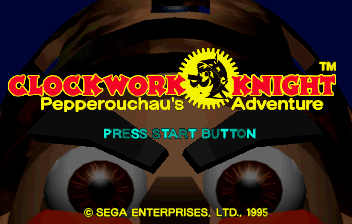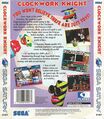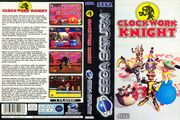Clockwork Knight
From Sega Retro
| Clockwork Knight | |||||
|---|---|---|---|---|---|
| System(s): Sega Saturn | |||||
| Publisher: Sega | |||||
| Developer: Sega | |||||
| Genre: Action | |||||
| |||||
| This article needs cleanup. This article needs to be edited to conform to a higher standard of article quality. After the article has been cleaned up, you may remove this message. For help, see the How to Edit a Page article. |
Clockwork Knight, known as Clockwork Knight: Pepperouchau no Daibouken Joukan (クロックワークナイト ~ペパルーチョの大冒険・上巻~) in Japan, is a side-scrolling platform video game, released as a launch title for the Sega Saturn in Japan on December 9, 1994 and in North America and Europe in 1995. It was followed by a sequel, Clockwork Knight 2.
Contents
Story
Sir Tongara de Pepperouchau III ("Pepper" for short) is a toy soldier. He is in love with the Clockwork Fairy Princess, Chelsea, whose voice wakes up the toys of the house every night at midnight. But he is clumsy and something of a laughingstock, especially when compared to his friendly rival Ginger who is also after Chelsea's heart.
One night Chelsea is stolen away by an unknown force, which also hypnotizes some of the lesser toys to become fierce minions and stand in the way of anyone who would try to rescue her. If there's no voice to wake them up anymore then the toys will never live again, so Pepper and Ginger head off to find Chelsea before it's too late.
Characters
- Sir Tongara de Pepperouchau III ("Pepper") - the main protagonist and sole playable character in the main game. He's brave, dashing, and quite clumsy.
- Barobaro - Pepper's nearsighted but ever-faithful donkey-for-a-steed. He appears to be a wine bottle on a wheeled basket. He has a crush on Soltia. Pepper rides on Barobaro's back in a few stages of Clockwork Knight 2, but in this game he only appears in cutscenes.
- Prunchau - Pepper's valet and close friend, this top is also very conscientious of Pepper and sometimes treats him like a little boy. He gives suggestions in the Soltian Roulette.
- Sir Ginger - Pepper's chief rival and something of a showoff, but he works with Pepper in saving Chelsea.
- Silver - Ginger's steed. A horse-shaped clothesbrush, he's quite snobby in thinking he's the perfect horse for the perfect warrior.
- Le Bon - Ginger's valet. Like Prunchau, he also gives suggestions in the Soltian Roulette.
- Sir Oneon de Pepperouchau - Pepper's father. He's a bit overly dramatic; he thinks, for whatever reason, that his family has forsaken him.
- Sir Garluch de Pepperouchau - Pepper's highly-respected, if somewhat misguided, grandfather. He's mysteriously gone missing.
- Pa Zur - Ginger's lord and mentor. All the toys think that the sliding puzzle is a wise old mystic.
- Soltia - A hot-tempered perfume bottle who loves music, cards, and games of chance. She has a crush on Pepper and considers Chelsea to be a rival for his affection. She hosts the Soltian Roulette mini-game that occurs between worlds, also giving suggestions to players like Prunchau and Le Bon do.
- Clockwork Princess Chelsea - This beautiful young doll's voice has the power to wake all the toys every night at midnight. Both Pepper and Ginger compete for her heart. Her kidnapping starts the events of this game and its sequel.
Gameplay
This game is a side-scrolling platformer in the vein of the Mario and Sonic the Hedgehog series. Unlike those games however, the game uses prerendered digitized 2D sprites of high-resolution 3D models similar to the Donkey Kong Country series, or Killer Instinct, on top of fully 3D levels (and with fully 3D bosses).
Pepper attacks enemies with his key. A quick tap of the button (usually B) will thrust it out horizontally. (He cannot do this vertically.) Likewise, repeatedly tapping the button over and over will cause him to twist the key around and around. This makes it a bit more powerful (e.g.: an enemy could be knocked out temporarily with a simple jab, but running into the key when twisting it will instantly take it out with a pop sound and lots of confetti). In addition to all this, he can also pick up unconscious enemies, or the objects such as footballs or springs that have been scattered around the stages and, toss them (in this case, vertical attacks are possible).
The goal is to reach the end of the stage before time or hit points (typically three, though Gold Keys can increase that maximum) run out. There are no checkpoints: dying sends a player back to the beginning of a level. The levels are fairly large (but not as large as the sequel's levels) and contain numerous side areas with treasures.
Every third level, Pepper must face off against a large, fully polygonal boss in a one-on-one battle. Each boss has a weakness that must be exploited. For instance, the first boss is a doll with a gigantic indestructible hat that it uses for cover; the doll can be hit during the moments when it is revealed under the hat. The final boss is an insane television that is bent on Pepper's destruction.
The game is not very long, with only thirteen levels. It does not save a player's progress; turning the Saturn off requires the player to start from the beginning next time. The thirteen levels take place in four different rooms with two normal levels and one boss each, plus a final boss that can only be fought when playing it on Normal or Hard; in Training difficulty, the game ends at the level just before the final boss.
Items
Clockwork Knight has these items lying around for collection:
- Imperial Crowns - Bottle caps with pictures of crowns on them, these are used in the Soltian Roulette mini-game or to earn a game continue.
- Pocket Watches - Scattered around almost as much as Imperial Crowns, these award either one or five bonus seconds on the timer.
- Keys - These wind-up keys will refill health. They come in three colors; Bronze Keys refill one point, Silver Keys refill all points, and Gold Keys refill all points and increase the maximum by one (this works twice per life, giving up to five hit points total). If Pepper is already at full health with five hit points, the gold key awards an extra life.
- Helmets - A blue helmet awards an extra life, and the much-rarer red helmets award three extra lives.
- Pa Zur Sphere (Invincible) - This makes Pepper invincible for a short time.
Rooms
There are four rooms in the game with three levels each, and a final boss level at the very end.
Betsy's Room
This level is rather linear, making it an easy start for newcomers. Boxes in the background fall onto unsuspecting players. Books slide back and forth in their shelves, threatening to knock Pepper off. Dinosaur bones hang from the ceiling and can hold various goodies for those willing to go up and check them out. The boss is Bob, the giant hat-carrying, blue-skinned (much like the Edisons from Maniac Mansion), tuxedo-wearing doll.
Kevin's Room
Things get tougher here, with numerous battery-powered trains riding tracks over bottomless pits; Pepper had better hop on or else things could get ugly. The floors of the world are often made of LEGO-like blocks, mostly contrasting from the blue background of the stage. Switches can lift various obstacles out of a player's way, or trap them inside if they're not careful. The boss is a large mech, which can transform into a speedy jet.
Kitchen
Sinks fill with water and drain right back on as Pepper hops from sponge to plate keeping himself from a scalding-hot fate. The metal floors seem to be highly slippery, mimicking the common ice-floor downfalls in many other video games. Watch out for flames from the stoves - pushing some soap and then riding it over them is advised. The boss is a chef-shaped salt shaker with a large pot he carries around, hiding under on the slippery floor.
Attic
Dark, damp and dusty would describe Pepper's final destination (in this trip, at least). Various mazes and platforms that rise and fall are scattered everywhere... Pepper's definitely getting closer to Chelsea and her kidnapper. The boss is yet another mech, a monkey-like one, that breaks apart early on causing its main body to float around, using all but its head as protection by spinning them around at high speeds.
Final Boss
This is the very end of this game - a final one-on-one battle with what appears to be the perpetrator over just who gets Chelsea. But is there a bigger foe at work here? The boss seems to be implying such...The final boss seems to be a television set.
Soltian Roulette
After finishing the boss level of a room (save the Attic or the final boss), the player can play this mini-game with Soltia, Prunchau and Le Bon. Essentially, the player bets Imperial Crowns on the likelihood of getting something from a roulette of various things (ranging from more Imperial Crowns, 1UPs, 3UPs, to clown faces, from which the player gains nothing). After betting 5, 10 or 15 Imperial Crowns, the roulette boxes will reveal the contents (the amount of everything varies depending on how much the player bets) then go for a quick spin, after which the player chooses which box the player thinks has what is desired. If the player gets something, it can be kept, or spin again for a double-or-nothing round (this can be done four times, with the amount of doubles going down by one each time). It's certainly not a bad idea to play this, as the later levels can be pretty tricky.
Saving Data
The game makes use of the Saturn's internal battery back-up to save data for system configuration.
| Name | Comment | File Size |
|---|---|---|
| CLOCK__DATA | FUKUBUKURO | 1 |
Production Credits
Executive Producer: Mamoru Shigeta
Producers: Noriyoshi Oba, Yoji Ishii, Makoto Oshitani
Director: Tomoyuki Ito
Sound Director/Music Composer: Hirofumi Murasaki
Main Character Artists: Toshiyuki Mukaiyama, Ryichiro Kutsuzawa
System Programmer/Main Character Programmer: Yoshio Fukushima
Background Programmer/Visual Effect Programmer: Akira Ohe
Front Stage Artists: Namie Manabe, Takehiko Miura, Yoshihito Takahashi
Background Artists: Shiro Kinemura, Masahiro Sanpei, Osamu Ogata, Yumiko Miyabe
Visual Coordination: Katsuhisa Sato
Map Condstrction: Hiroshi Ohba
Enemy Programmers/Trap Programmers: Takashi Amami, Toshihiro Aumazaki (Hitachi Microsoftware System. Inc.)
Boss Enemy Programmers/Trap Programmers: Shinya Tsukizaki, Hiroaki Sakamoto, Tetsu Katano
World Map & Goal Programmer: Hiroshi Momota
Opening Programmer/Ending Programmer: Yoshio Inoue
Bonus Game Programmer: Yuichi Matsuoka
Boss Enemy Designer: Yusuke Yoshida
Opening Artist/Ending Artist: Norihiro Nishiyama
Graphical Supervisor: Mayayuki Hasegawa
Sound Effects: Seirou Okamoto, Katsuyoshi Nita
Sound Programmers: Kazuya Fujishima, Naomi Yamamoto, Kenichiro Okuma
Sega Sound Libary: In Vision
Recording Studio: Sega Digital Studio
Recording Producer: Tatsutoshi Narita
Recording Director: Fumitaka Shibata
Recording Engineer: Naoyuki Machida
Product Manager: Tomoaki Ogawa, Kazuhiro Hanaya
Promotion: Tadashi Takezaki
Special Thanks: Toru Sasaki, Tsutomu Kataoka, Asami Sasaki, Shinji Kawahira, Yosuke Okunari, Tomoko Hasegawa
Produced & Published By: Sega Enterprises. Ltd.
Opening Theme (Clockwork Knight)
Vocals By: Misumi Kosaka, Shiori Fujita
Words By: Reiko Waters
Music By: Hirofumi Murasaki
Arranged By: Tomoko Tsuyama
Manipulated By: Nobuo Ito
Credits Theme (A Lullaby)
Vocals By: Misumi Kosaka
Words By: Reiko Waters
Music By: Hirofumi Murasaki
Arranged By: Tomoko Tsuyama
Manipulated By: Nobuo Ito
Physical Scans
| 74 | |
|---|---|
| Based on 50 reviews | |
| Saturn, BR |
|---|
| <div style="margin:auto; max-width:Expression error: Unexpected < operator.px">
320x120px Cover
|
- ↑ 1700 igr dlya Sega, "" (RU; 2001-xx-xx), page 48
- ↑ Alaab Alcomputtar, "" (SA; 1995-08-xx), page 74
- ↑ CD Consoles, "Février 1995" (FR; 1995-xx-xx), page 120
- ↑ Consoles +, "Février 1995" (FR; 1995-0x-xx), page 118
- ↑ Computer & Video Games, "February 1995" (UK; 1995-01-15), page 28
- ↑ Digitiser (UK) (1995-07-11)
- ↑ Edge, "March 1995" (UK; 1995-01-26), page 72
- ↑ Electronic Entertainment, "August 1995" (US; 1995-0x-xx), page 77
- ↑ Electronic Gaming Monthly, "July 1995" (US; 1995-0x-xx), page 38
- ↑ Excalibur, "" (CZ; 1995-08-01), page 1
- ↑ Famitsu, "1994-12-30" (JP; 1994-12-16), page 1
- ↑ GameFan, "Volume 3, Issue 7: July 1995" (US; 1995-xx-xx), page 13
- ↑ Game Players, "Vol. 8 No. 8 August 1995" (US; 1995-0x-xx), page 36
- ↑ GamePro, "April 1995" (US; 1995-xx-xx), page 144
- ↑ GamePro, "August 1995" (US; 1995-xx-xx), page 54
- ↑ Games World: The Magazine, "September 1995" (UK; 1995-0x-xx), page 69
- ↑ Hobby Consolas, "Agosto 1995" (ES; 1995-xx-xx), page 98
- ↑ Joypad, "Décembre 1994" (FR; 1994-1x-xx), page 162
- ↑ Joypad, "Septembre 1995" (FR; 1995-0x-xx), page 70
- ↑ LeveL, "Červen 1995" (CZ; 1995-06-01), page 36
- ↑ MAN!AC, "02/95" (DE; 1995-01-11), page 26
- ↑ MAN!AC, "08/95" (DE; 1995-07-12), page 46
- ↑ Maximum, "October 1995" (UK; 1995-09-01), page 145
- ↑ Mega, "April 1995" (UK; 1995-03-30), page 18
- ↑ Mega Force, "Janvier 1995" (FR; 199x-xx-xx), page 52
- ↑ Mega Fun, "08/95" (DE; 1995-07-19), page 83
- ↑ Mean Machines Sega, "February 1995" (UK; 1994-12-30), page 84
- ↑ Mean Machines Sega, "October 1995" (UK; 1995-08-25), page 90
- ↑ Next Generation, "April 1995" (US; 1995-03-21), page 89
- ↑ Player One, "Juillet/Août 1995" (FR; 1995-0x-xx), page 64
- ↑ Power Unlimited, "Jaagang 3, Jul/Aug 1995" (NL; 1995-06-28), page 38
- ↑ Saturn Fan, "1995 March" (JP; 1995-02-08), page 40
- ↑ Saturn+, "Christmas 1995" (UK; 1995-12-14), page 56
- ↑ Score, "Květen 1995" (CZ; 1995-05-01), page 30
- ↑ Sega Magazin, "August 1995" (DE; 1995-07-12), page 65
- ↑ Sega Magazine, "August 1995" (UK; 1995-07-13), page 60
- ↑ Sega Power, "April 1995" (UK; 1995-02-16), page 63
- ↑ Sega Pro, "March 1995" (UK; 1995-01-26), page 34
- ↑ Sega Pro, "September 1995" (UK; 1995-08-10), page 50
- ↑ Sega Megazone, "August 1995" (AU; 1995-0x-xx), page 24
- ↑ Sega Saturn Magazine, "Readers rating final data" (JP; 2000-03), page 14
- ↑ Super Juegos, "Agosto 1995" (ES; 1995-0x-xx), page 82
- ↑ Todo Sega, "Septiembre 1995" (ES; 1995-0x-xx), page 36
- ↑ Tricks 16 bit, "Tricks Sega Gold 800 igr" (RU; 1998-03-20), page 44
- ↑ Ultimate Future Games, "September 1995" (UK; 1995-08-01), page 89
- ↑ Ultimate Future Games, "March 1995" (UK; 1995-02-03), page 82
- ↑ Ultimate Gamer, "July 1995" (US; 1995-0x-xx), page 89
- ↑ Última Generación, "Abril 1995" (ES; 1995-0x-xx), page 78
- ↑ Video Games, "8/95" (DE; 1995-07-26), page 67
- ↑ VideoGames, "June 1995" (US; 1995-0x-xx), page 72
- No players field
- Old content rating field
- All games
- Cleanup
- Old-style rating (cdconsoles)
- Rating without PDF source
- Old-style rating (consolesplus)
- Old-style rating (edge)
- Old-style rating (egm)
- Rating without source
- Old-style rating (gamefan)
- Old-style rating (gameplayers)
- Old-style rating (gamesworld)
- Old-style rating (hobbyconsolas)
- Old-style rating (joypad)
- Old-style rating (maniac)
- Old-style rating (maximum)
- Old-style rating (mms)
- Old-style rating (playerone)
- Old-style rating (segapower)
- Old-style rating (segapro)
- Old-style rating (ufg)
- Old-style rating (vgce)
- Update ratings template
- 19 old ratings
- Pages with broken file links
- Unreleased 32X games








